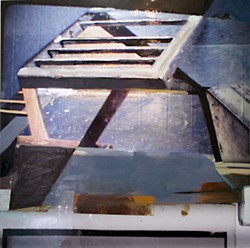Sonya Berg’s Redefines Art – Austin Chronicle Review
http://www.austinchronicle.com/arts/2013-03-29/sonya-berg/
The Austin Chronicle Review
‘Sonya Berg’
In her show at Tiny Park Gallery, Berg’s painted-over photographic collages vividly, beautifully, redefine art
Reviewed by Wayne Alan Brenner, Fri., March 29, 2013
‘Sonya Berg’
Tiny Park Gallery, 1101 Navasota
www.tinyparkgallery.com
Through March 30
“You have confused the true and the real” is the epigraph at the beginning of Samuel R. Delany’s Dhalgren, the novel that Annabelle Sanders is reading as she sits eating fresh oysters on the patio of Hillside Farmacy near the triple intersection of East 11th, Rosewood, and Navasota. Just across from her sits Tiny Park Gallery, and Annabelle, squinting, can almost discern the small, bright-red Christmas tree that is the venue’s logo.
Tiny Park is next on her agenda, after the oysters, after another dozen pages of Dhalgren. The gallery’s interior walls are complicated by a show of works by Sonya Berg, in which the artist has intentionally confused the true and the real. The works are of various sizes: some as small as beer coasters, a few the size of computer screens, one that might challenge the silhouette of a Smart Car. They’re paintings, these works. Or, no, they’re photographs. Actually, they’re both, as Berg commits simple collages of photographic prints and then paints over parts of them, precisely reproducing what she’s painting over. Or, perhaps, obscuring what now lies beneath. Or maybe fabricating new patterns or components upon the photographs, so that the exterior of a mountain cabin, say, suddenly blossoms a section more redolent of impressionism than of modern image-capture. It’s hard to tell, sometimes. And sometimes, we’re thinking, that’s the point.
Annabelle navigates a raw, lemon-spiked oyster down her throat, turns a page, and considers what her friend Brenner has told her about Exit, one of the bigger and more complex renderings by Berg at Tiny Park. It’s a conflation of views of a window hatch and a ladder, it seems, with swaths of painterly, oil-based mimicry standing in for much of the original photo-emulsion, forming the planes and lines and angles of gray, white, black, and blue.
“I think Exit kind of speaks for Berg’s whole process,” Brenner said. “It describes the way out that she’s found – out of the traps of art, the pigeonholes that people try to put an artist in. And, especially now, with so much of the world being replicated in the Net, if art is going to imitate life at all, it’s also got to imitate the universal abstractions – those realistic representations in cyberspace, and the ways that photographs are manipulated for commercial purposes – that are often more immediate for so many of us these days. It makes more and more sense to confuse the true and the real – as George Stanley said, in that quote at the beginning of Dhalgren.”
“Well,” said Annabelle, “but then, eventually, maybe those words will have to be redefined.”
And maybe they’re already being redefined – vividly, beautifully – on the walls of Tiny Park.
